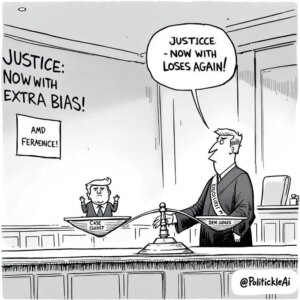The Legal Tug-of-War: Immigration Parole Programs and the Role of Activist Judges

The ongoing debate around immigration policies in the United States has recently intensified, sparking a significant legal battle. A group of migrants has filed a lawsuit against the Trump Administration, seeking to extend immigration parole programs initiated during the Biden era. This program granted undocumented migrants, along with their families, a two-year reprieve to live and work in the U.S.
However, the legal landscape changed dramatically when former President Trump executed an executive order at the start of his presidency aimed at terminating “all categorical parole programs.” In response, U.S. District Judge Indira Talwani of Massachusetts, recognized for her Obama-era appointment, has stepped in. Her rulings have effectively blocked the administration’s ability to deport migrants on a case-by-case basis, thus ensuring that thousands of undocumented individuals remain in the country.
The Judge’s Rationale
In one of her recent orders, Judge Talwani emphasized the public interest in maintaining a stable status for these individuals. She argued that creating a scenario in which hundreds of thousands could become unlawfully present in the U.S. would only exacerbate social and economic issues. “It is not in the public interest to manufacture a circumstance in which these individuals cannot legally work in their communities or provide for themselves and their families,” she stated.
Behind the Activist Movement
Supporting this legal initiative is Human Rights First (HRF), a notable organization committed to influencing global human rights policies. With a vast network of over 300 partners in 50 countries, HRF seeks to prompt changes in governance that align with their human rights agenda. Their influence extends back to the Global Magnitsky Act, which has enabled the U.S. government to impose sanctions for human rights violations worldwide.
A Question of Jurisdiction
The crux of the issue lies in the powers granted to the executive branch. Critics argue that if the president can enact these parole programs, he should also have the authority to dissolve them. Many view Judge Talwani’s actions as a dangerous overreach of judicial power, raising eyebrows given her financial donations to political figures like Sen. Elizabeth Warren and former President Obama. This situation leads to a critical examination of whether certain judges can assess cases without bias, especially as many believe that their appointments were made with the intention to counteract Trump-era policies.
Turning Point in the Supreme Court
The Supreme Court recently intervened with a decisive 7-2 ruling affirming presidential authority to expel about 500,000 migrants currently in the U.S. Notably, Justices Ketanji Brown Jackson and Sonia Sotomayor dissented, highlighting the deep division among the justices on this contentious subject. The case now heads to the 1st Circuit Court of Appeals, where the legal battle continues.
As political leaders like Chuck Schumer have openly maintained, many of these judicial appointments were strategically made to counteract Trump’s initiatives. The ongoing conflict raises a fundamental question: Are these judges genuinely impartial, or are they swayed by personal biases?
Why This Matters to Investors
At Extreme Investor Network, we believe that understanding the intersection of law, policy, and economic stability is crucial for informed investing. The immigration debate is not merely a political concern; it impacts labor markets, consumer demand, and overall economic health. As investors, paying attention to these shifts can unlock opportunities in sectors that may benefit from changes in labor supply, consumer spending, and even housing markets.
By staying informed about these developments, you can better evaluate potential risks and opportunities arising from shifting immigration policies. With the legal landscape evolving, the implications for economic growth and community stability remain profound.
For in-depth insights and analysis on these topics, consider following our blog to stay ahead of the curve in economics and investment strategies.

